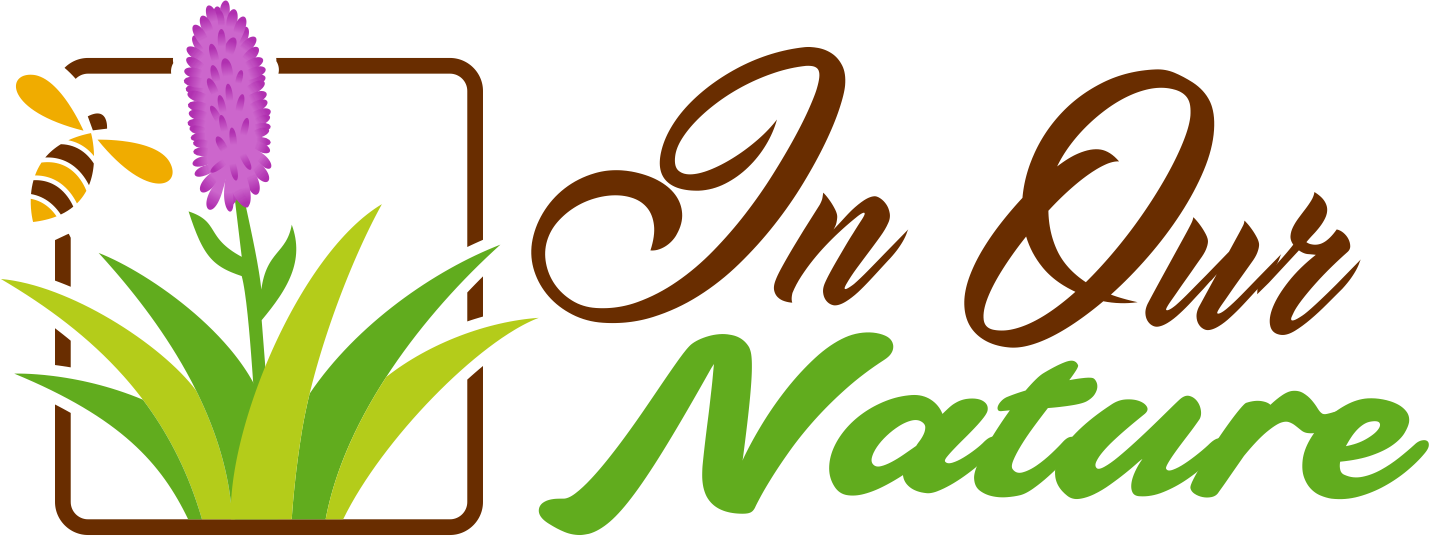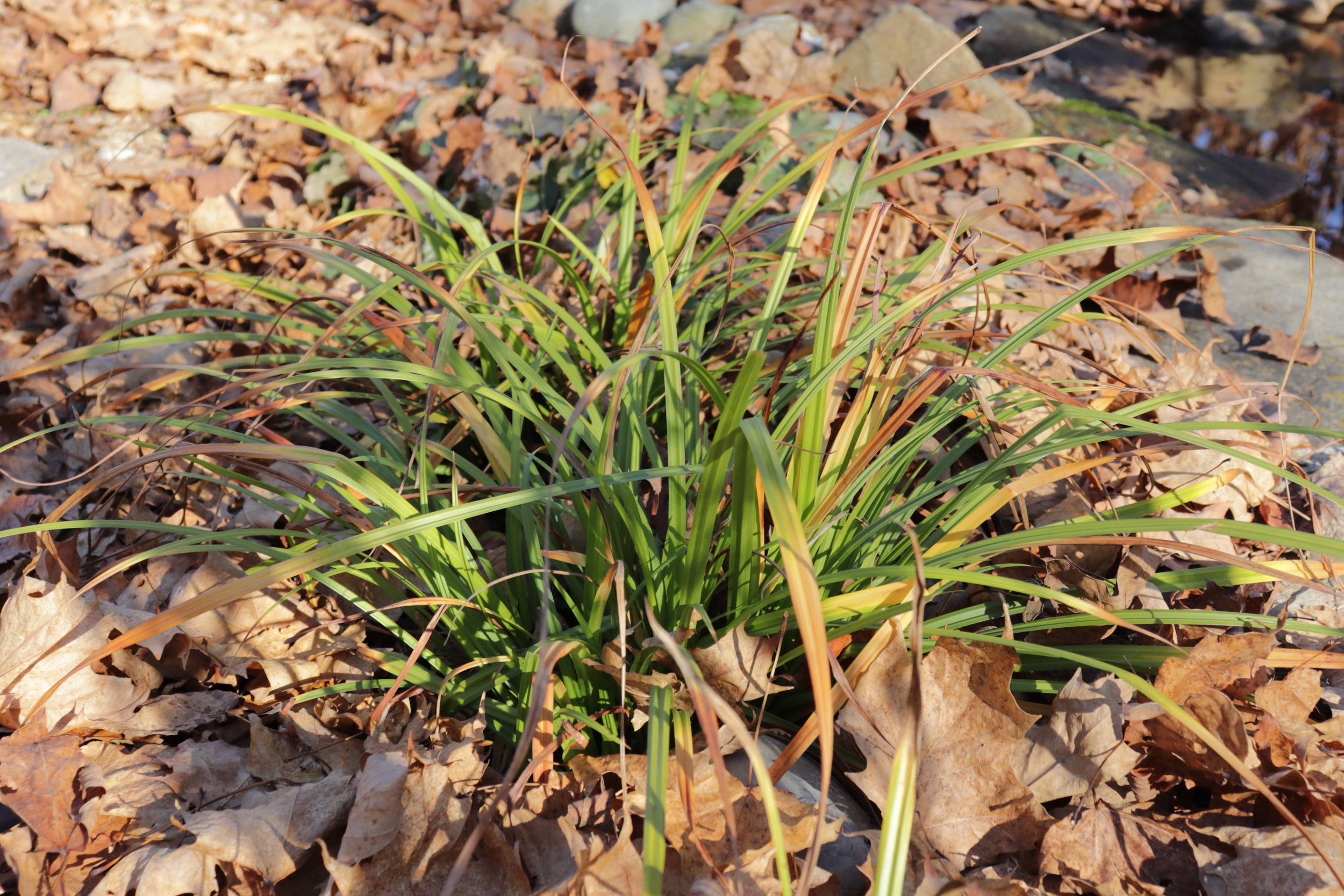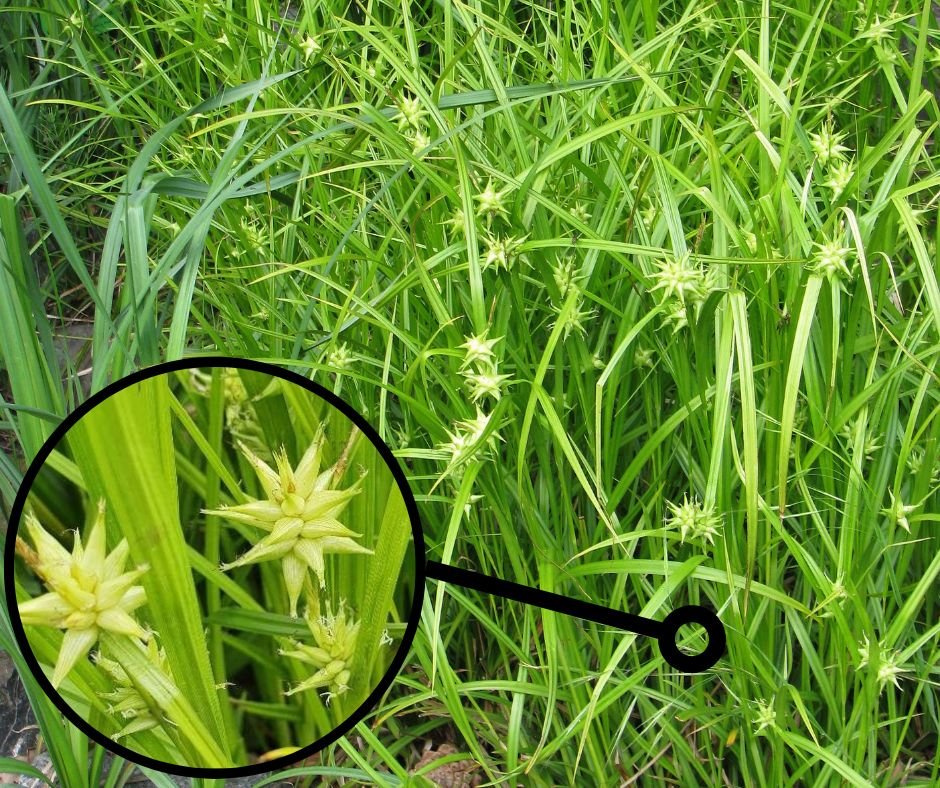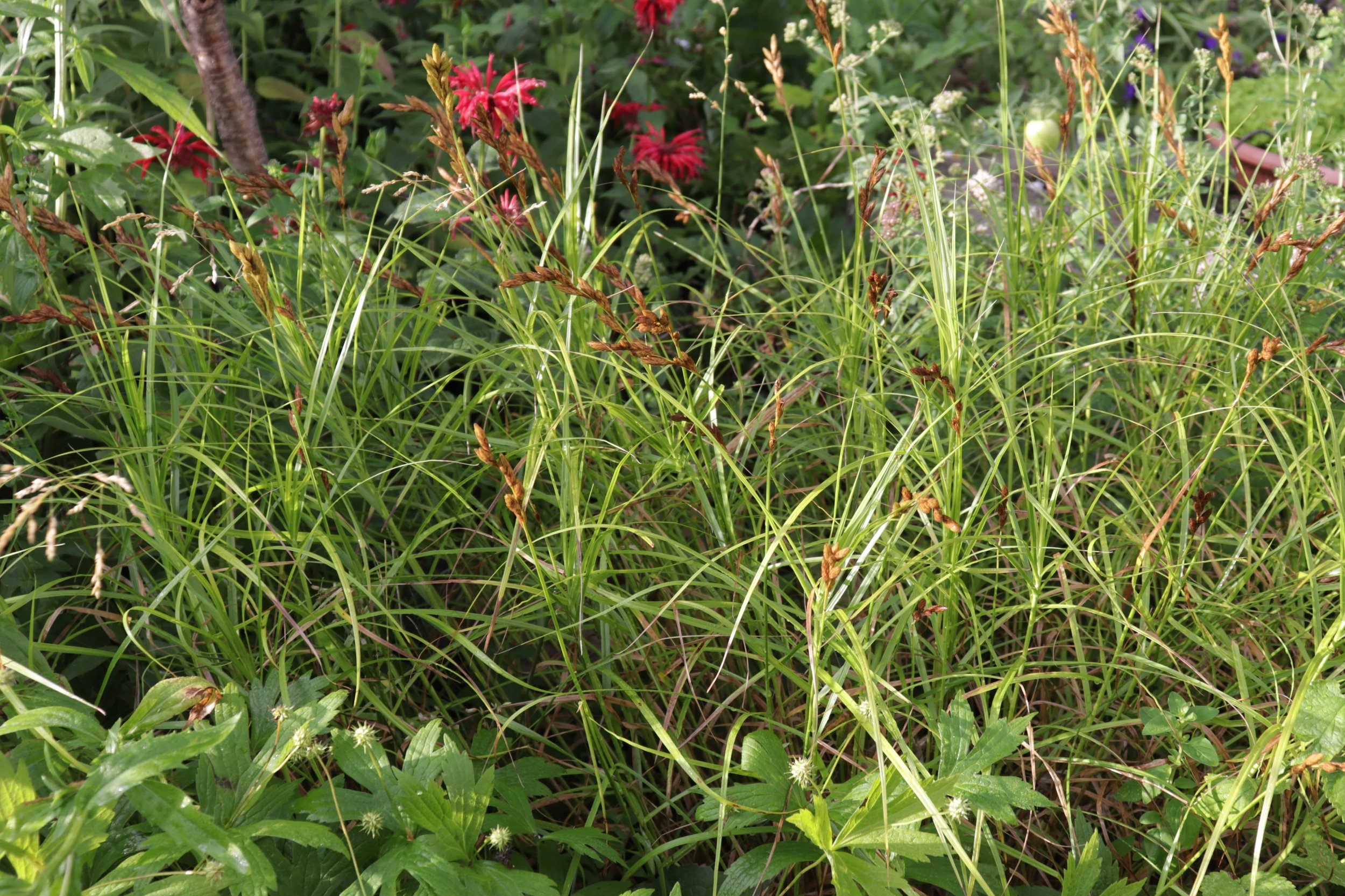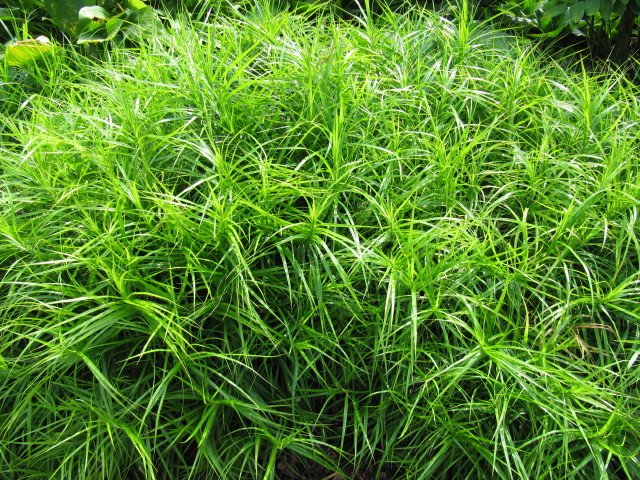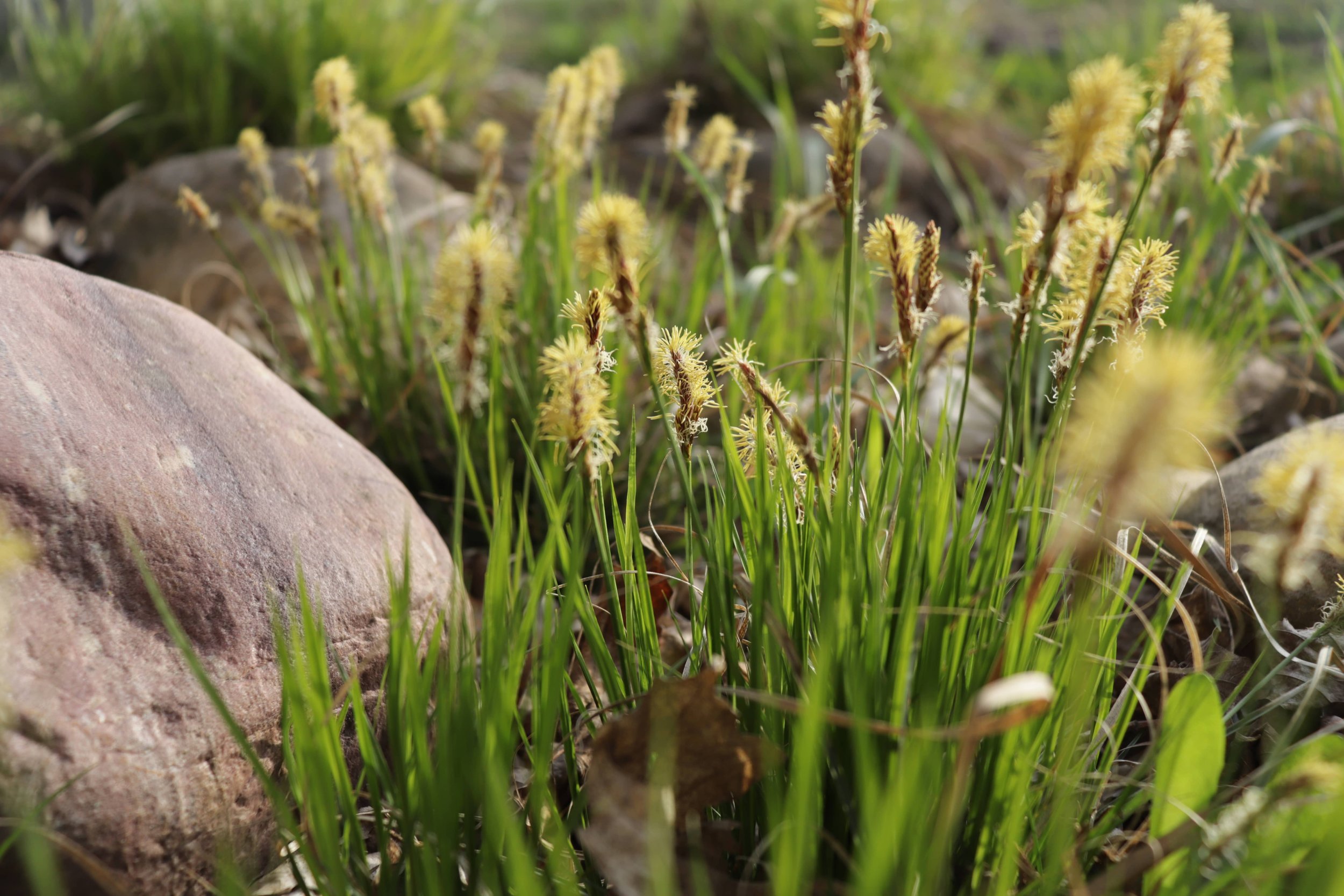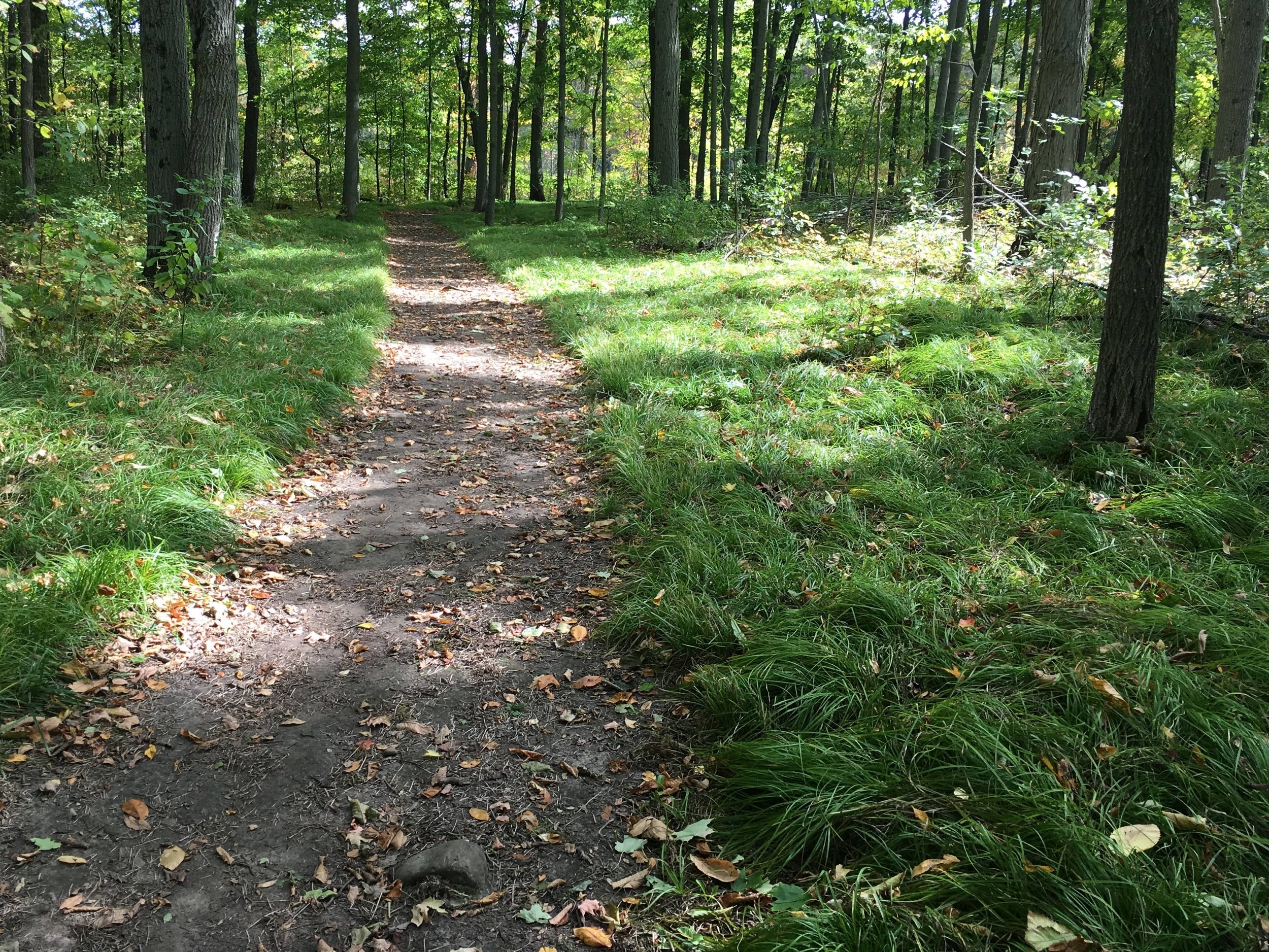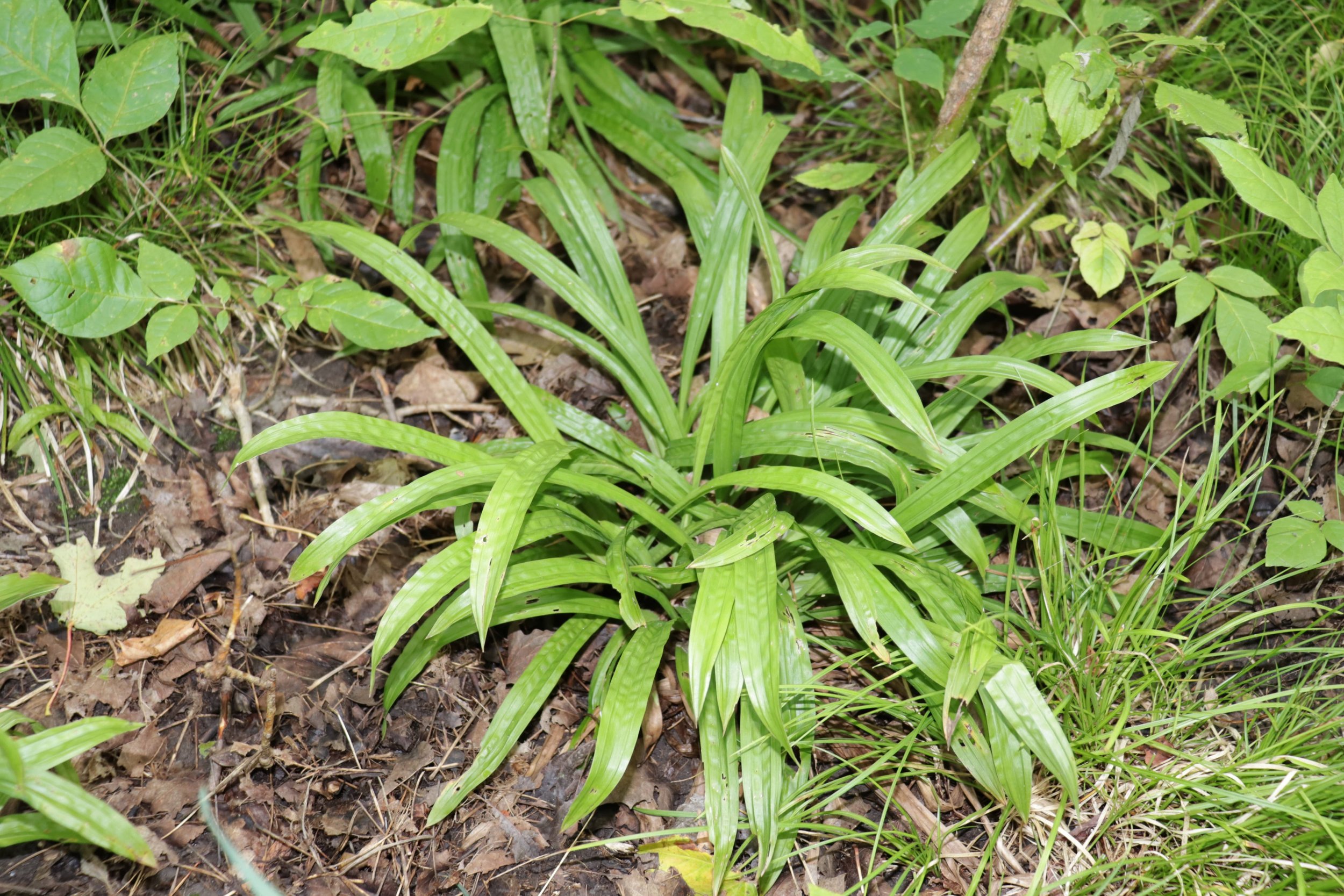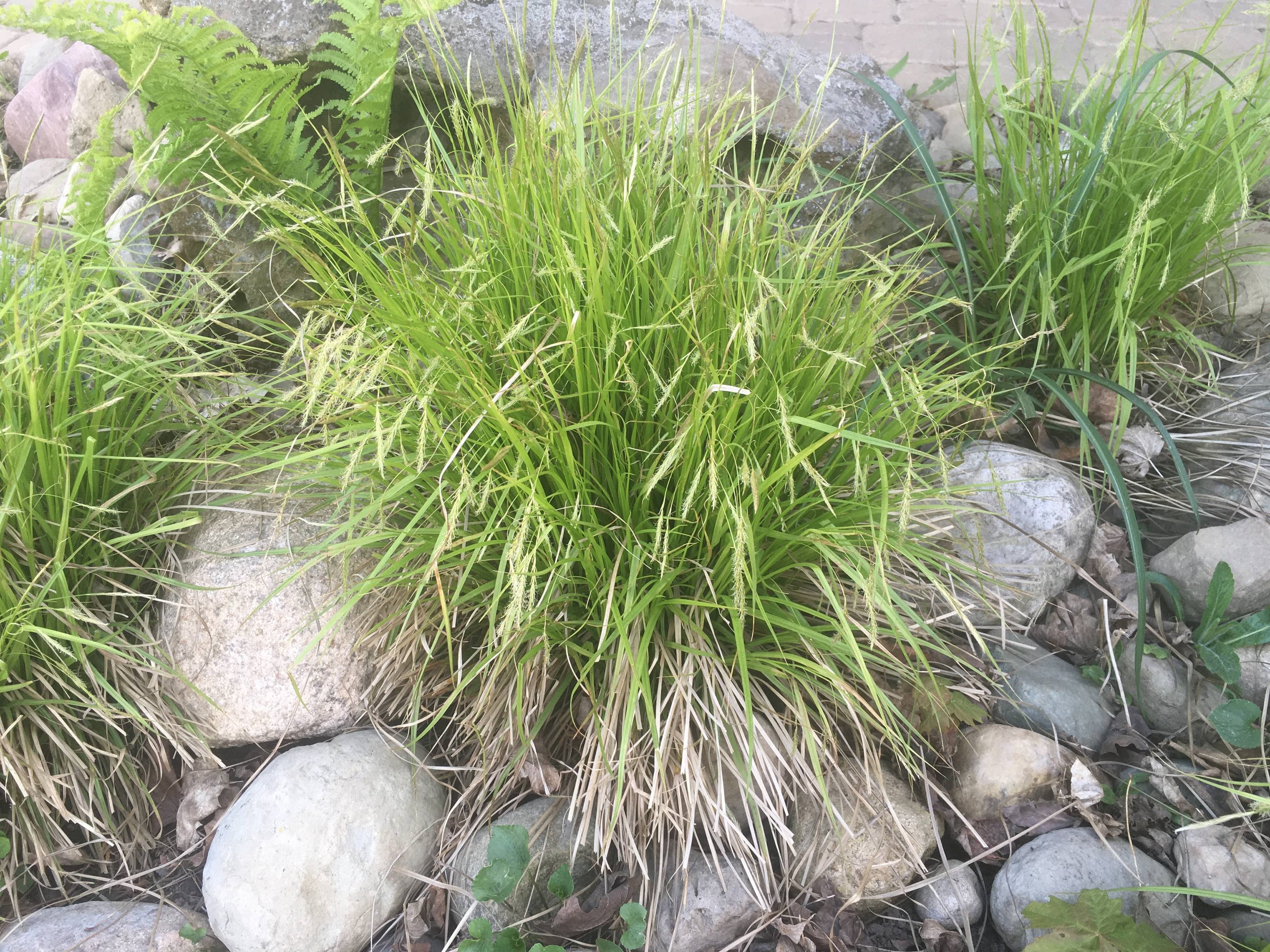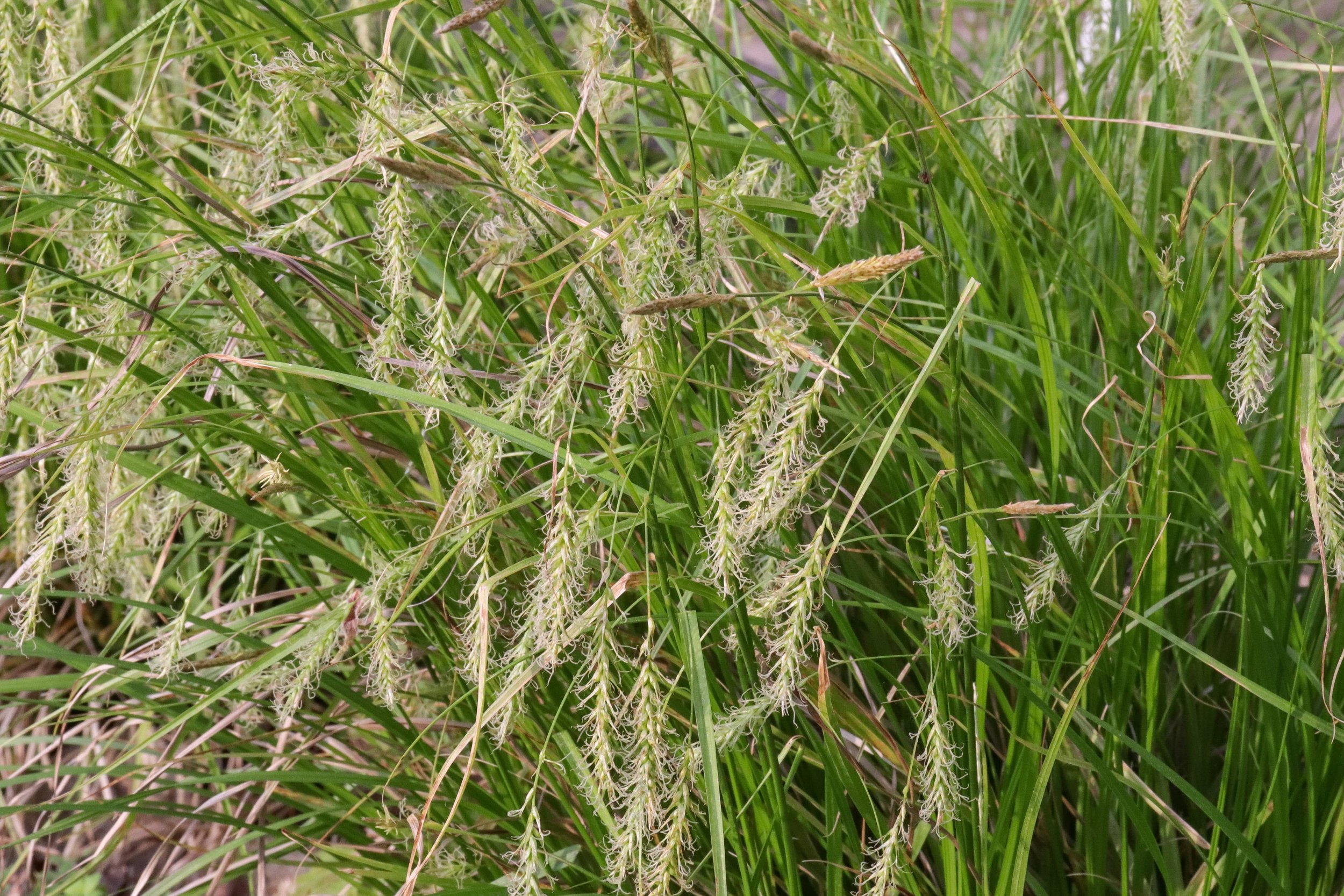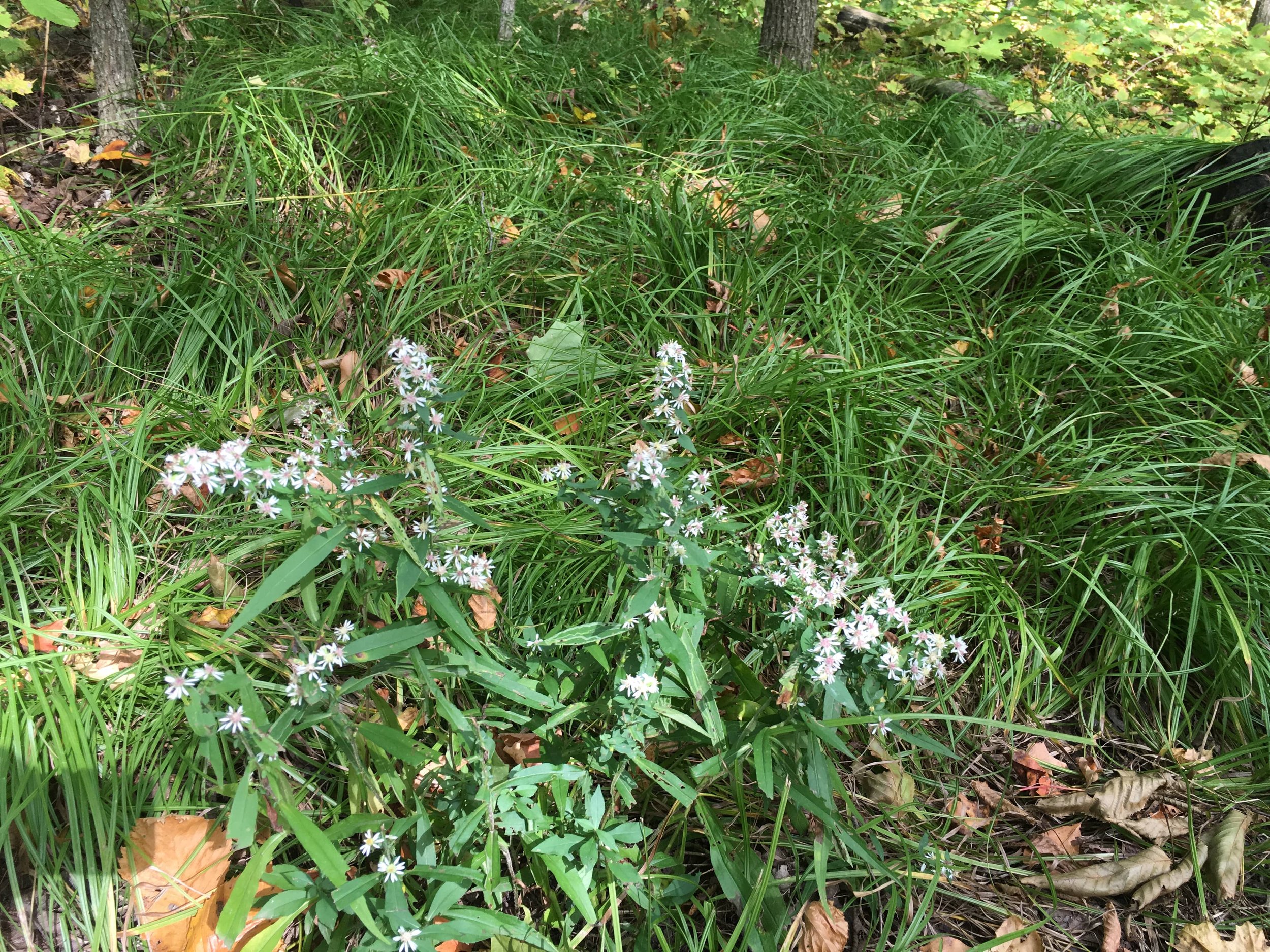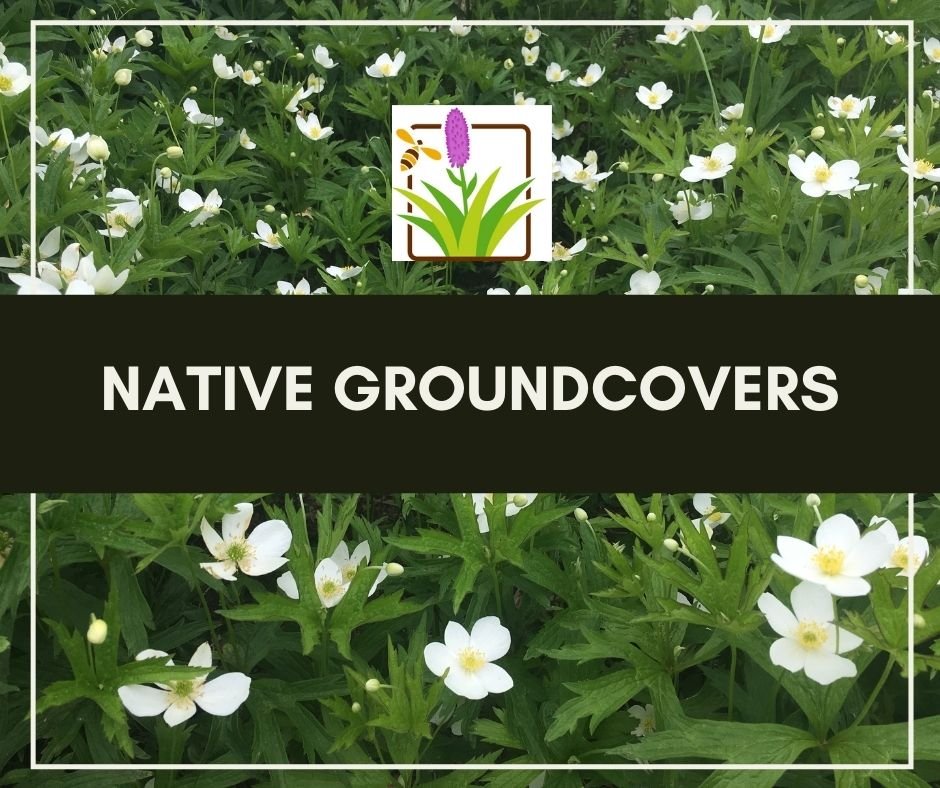Native Sedges For Your Garden
| Sedges - the unsung hero’s of natural garden design |
What are sedges?
Sedges (Carex spp.) are highly diverse genus of grass-like plants found through-out cold and temperate regions. With over 2000 species of Carex throughout the world and about in 248 in Ontario alone, they provide aspiring natural gardeners with a lot of exciting planting opportunities!
How are sedges different to grasses?
Grasses and sedges may look similar, but they are in completely different plant families (for the true plant nerds, they are in the Poaceae and Cyperaceae families, respectively).
The easiest way to tell if the plant you’re looking at is a grass or a sedge is to look at their stems. Generally speaking, grass stems are hollow, with solid nodes, and a cylindrical in cross-section. On the other hand, sedges are solid with a triangular cross section.
Here is an easy way to remember:
Sedges have edges,
Rushes are round,
Grasses have nodes from the top to the ground.
I won’t go into any more detail on sedge identification in this article but you can learn more about sedges here.
Why are sedges important?
Sedges are an important part of many ecosystems. They are an important part of your natural garden too!
The incredible diversity of sedges in Ontario means that they have become indispensable parts of native ecosystems, providing many important services such as erosion control, wildlife habitat, host plants and more. They are mainly water-loving but can be found through a diversity of ecosystems in Ontario from meadows to forests to wetlands.
Although quite overlooked in the nursery trade, they are becoming more popular with native plant enthusiasts and natural garden designers for their adaptability, beauty and wildlife value.
Benefits of sedges in your garden
Great for pollinators
Sedges are wind pollinated and don’t provide much value to bees, but they are valuable host plants for butterflies and moths. For example, oak sedge feeds the caterpillars of 36 species of butterfly!
Semi-evergreen groundcovers
Sedges are cool-season growers, meaning they grow best in the cool weather of spring and fall. They also stay green late into fall and green up early in the spring, helping you extend the green theme in your garden for as long as possible.
Sedges play well with others
Being so common in a variety of ecosystems, sedges have adapted to grow well, and look good, with a variety of other plants from the same ecosystem. For example, pink milkweed is beautiful but it can take on a leggy look around its base. Pair it with sedges that would naturally grow with it and you can hide the leggy stem while creating a natural team! You can even plant sedges as a groundcover in between already established perennials to cover the ground and provide more habitat.
Bird food
The seed heads of sedges are not only attractive to the eyes of humans, but also to hungry birds. Many birds such as juncos, towhees, sparrows, ducks, grouse or even wild turkeys will come to feast on the seeds of sedges.
Sedge are undervalued by gardeners and nurseries, but that is slowly changing as gardeners become aware of the benefits of sedges. At In Our Nature Native Plant Nursery, we have been working on increasing our supply of sedges. Below, I have compiled a list of the easiest to grow, most commercially available sedges for Ontario and surrounding states/provinces.
1. Golden Sedge (Carex aurea)
The fountain-like clumps of golden sedge add brightness to shady areas with its golden-green foliage.
It is a non-aggressive spreader that grows best in moist sites but will readily adapt to slightly drier conditions in your garden once established.
Golden sedge likes to be the star of the show, so don’t plant it with taller, more aggressive plants that can outcompete it.
Exposure: Full sun to part shade
Height / Spread: 45cm,18” / 90cm, 3ft
Soil: Sandy, rocky, organically rich. Prefers calcareous soil.
Moisture: Wet to average. Tolerates a few inches of standing water.
Habitat: Wetlands, shorelines, bogs, conifer swamps
Companions: blue-flag Iris, turtlehead, pink milkweed, blue vervain.
2. Ebony Sedge (Carex eburnea)
A dainty, clumping sedge with a short stature and golden-green glow.
Spreads slowly by rhizomes to form a soft-textured groundcover in either shaded or sunny sites. Small, white-green flowers bloom in the spring and are more noteworthy when planted en masse.
Exposure: Part sun to full shade
Height / Spread: 30cm, 1ft, 15cm, 0.5ft
Soil: Sandy, rocky, shallow. Often found growing out of cracks in limestone bedrock.
Moisture: Prefers consistent moisture but drought tolerant once established.
Habitat: Dry slopes, pine plantations, upland forests, Niagara escarpment
Companions: Red columbine, oak sedge, woodland phlox, most woodland spring ephemerals.
3. Mace Sedge (Carex grayi)
A clump-forming sedge with broad leaves and interesting, mace-like seed pods.
Great for adding greenery and interesting texture to your garden, pond, rain garden or swale.
Seed heads often remain on the plant into winter. Height of plant depends on where it grows.
Exposure: Part sun to light shade
Height / Spread: 30-100cm, 12-40” / 40-120 cm (16-48")
Soil: Loam, sand. Fertile.
Moisture: Moist to average. Tolerates temporary flooding.
Habitat: Moist woodlands, streamsides, wet meadows
Companions: Turtlehead, cardinal flower, blue lobelia, blue-flag iris
4. Palm Sedge (Carex muskingumensis)
An adaptable, water-loving sedge with unique leaf pattern resembling a palm leaf. It has the ability to thrive and look lush in most sunny gardens, granted the soil doesn’t go bone-dry.
Will grow in a couple inches of water in your pond. Attractive brown seed heads stand up straight above the droopy foliage from late summer into fall.
Palm Sedge spreads at a moderate rate to form a non-aggressive groundcover and works well with other perennials. Great choice for shallow (5cm, 2inch) water in your pond.
Exposure: Full sun
Height / Spread: 90cm, 3ft / 90cm, 3ft
Soil: Sand, loam, clay
Moisture: Wet, seasonally wet, average. Will grow in shallow water.
Habitat: Marshes, floodplains, low woods, wet meadows
Companions: King of the meadow, canada anemone, culvers root, bee balm, pink milkweed
5. Oak Sedge (Carex pensylvanica)
Oak sedge (a.k.a Pennsylvania sedge), is valued by natural garden designers for its use as a non-aggressive, shade tolerant groundcover (check out my list of native groundcovers) and its ability to thrive in the shade.
Sedges aren’t noted for their showy flowers but oak sedge really knocks it out of the park with small tufts of creamy-yellow flowers atop slender stalks.
Works well with other woodland plants to fill in gaps and create the perfect backdrop for other shade-tolerant flowers. Works well as a groundcover under pine/spruce trees but won’t be as dense.
Once established, it spreads at a moderate to fast rate by rhizomes. Tolerates dry shade.
Exposure: Shade to part sun. Tolerates deep shade.
Height / Spread: 30cm, 1ft / 30cm, 1ft
Soil: Sand, loam, shallow soils
Moisture: Dry, medium
Habitat: Deciduous forests (especially where oak trees are present)
Companions: An indispensable companion for most shade-loving perennials.
6. Seersucker Sedge (Carex plantaginea)
Also known as “plantain-leaf sedge” this shade-lover is one of a few native sedges with broad leaves. It maintains a highly ornamental, clumping form with gracefully arching lime-green leaves.
Use it as a bold accent to other more fine-textured plants such as oak sedge or bulblet fern. Clump forming and not aggressive.
Tolerates dry shade and shallow soils.
Exposure: Shade
Height / Spread: < 30cm, 1ft / 30cm, 1ft
Soil: Sand, loam, rocky. Prefers high organic content.
Moisture: Moist, well-drained.
Habitat: Rich upland woods, ravines
Companions: Oak sedge, sprengels sedge, wild ginger, red columbine, wood phlox
7. Rosy Sedge (Carex rosea)
Rosy sedge lends itself to shady sites where a more delicate look is desired.
It forms a dense clump of wispy, fine textured foliage that accents its small, scattered, star-like seed pods.
The combination of foliage and seed pods gives a unique, ethereal look to the garden.
It will spread slowly over time to form colonies and grows well under pine trees and as a lawn alternative.
Exposure: part sun to shade
Height / Spread: 30cm, 1ft / 30cm, 1ft
Soil: Sand, loam, clay, rocky. Prefers organically rich soil.
Moisture: Average to moist.
Habitat: Deciduous or mixed woods, pine plantations
Companions: Wild ginger, large leaf aster, woodland phlox, foamflower
8. Sprengel's Sedge (Carex sprengelii)
Sprengels Sedge should be a staple groundcover or accent plant for shaded sites. It forms attractive mounds of long, narrow, arching leaves.
Flower stalks rise up from clumps of light green foliage in early spring where they exhibit droopy clusters of greenish flowers.
Flowers mature into dangling seed heads that sway in the breeze and take on a golden glow as the setting sun light them up.
Exposure: Shade, part shade, part sun
Height / Spread: 90cm, 3ft / 30cm, 1ft
Soil: Most well-drained soils. Prefers rich soil.
Moisture: Moist, average
Habitat: Moist woods, floodplains
Companions: An indispensable companion for most shade-loving perennials.
9. Fox Sedge (Carex vulpinoidea)
Fox sedge maintains a nice clump of arching leaves that are accented by vertical flower and seed stalks.
It loves moisture but is fairly adaptable to most gardens where the soil doesn’t go bone dry.
Highly ornamental, bristly seed heads add wonderful textural interest to your garden.
Resistant to deer. May be a prolific spreader in ideal conditions (great for restoration!) but spreads more slowly in drier soils. Great choice for shallow (5cm, 2inch) water in your pond.
Exposure: Sun to part shade
Height / Spread: 120cm, 4ft / 120cm, 4ft
Soil: sand, loam, heavy clay. Tolerates both acid & alkaline soils.
Moisture: Wet, average, temporary flooding.
Habitat: Wetlands, wet meadows, swales, retention/detention ponds
Companions: Golden alexander, new york ironweed, pink milkweed, spotted joe-pye
